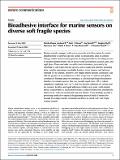Bioadhesive interface for marine sensors on diverse soft fragile species
Author(s)
Duque Londono, Camilo; Cones, Seth F; Deng, Jue; Wu, Jingjing; Yuk, Hyunwoo; Guza, David E; Mooney, T Aran; Zhao, Xuanhe; ... Show more Show less
DownloadPublished version (4.343Mb)
Publisher with Creative Commons License
Publisher with Creative Commons License
Creative Commons Attribution
Terms of use
Metadata
Show full item recordAbstract
Marine animals equipped with sensors provide vital information for understanding their ecophysiology and collect oceanographic data on climate change and for resource management. Existing methods for attaching sensors to marine animals mostly rely on invasive physical anchors, suction cups, and rigid glues. These methods can suffer from limitations, particularly for adhering to soft fragile marine species such as squid and jellyfish, including slow complex operations, unreliable fixation, tissue trauma, and behavior changes of the animals. However, soft fragile marine species constitute a significant portion of ocean biomass (>38.3 teragrams of carbon) and global commercial fisheries. Here we introduce a soft hydrogel-based bioadhesive interface for marine sensors that can provide rapid (time <22 s), robust (interfacial toughness >160 J m<jats:sup>−2</jats:sup>), and non-invasive adhesion on various marine animals. Reliable and rapid adhesion enables large-scale, multi-animal sensor deployments to study biomechanics, collective behaviors, interspecific interactions, and concurrent multi-species activity. These findings provide a promising method to expand a burgeoning research field of marine bio-sensing from large marine mammals and fishes to small, soft, and fragile marine animals.
Date issued
2024-04-16Department
Massachusetts Institute of Technology. Department of Mechanical EngineeringJournal
Nature Communications
Publisher
Springer Science and Business Media LLC
Citation
Duque Londono, Camilo, Cones, Seth F, Deng, Jue, Wu, Jingjing, Yuk, Hyunwoo et al. 2024. "Bioadhesive interface for marine sensors on diverse soft fragile species." Nature Communications, 15 (1).
Version: Final published version